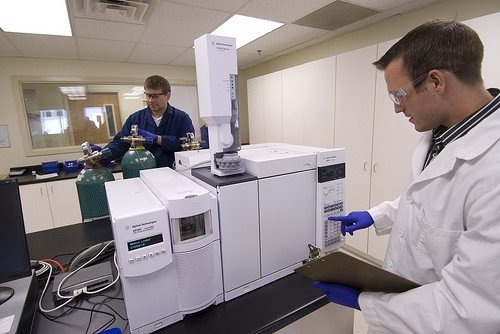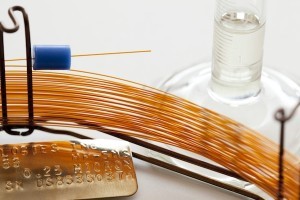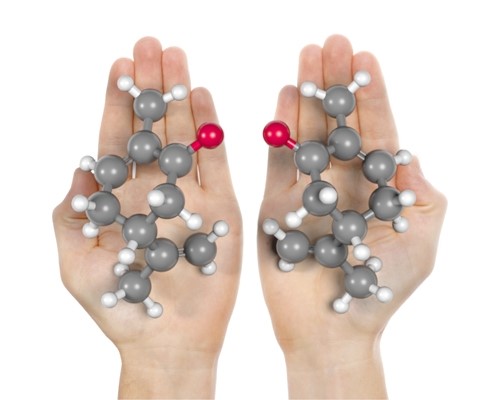PART 14: FINDING PURE ESSENTIAL OILS: GAS CHROMATOGRAPHY
EDITOR’S NOTE: Since Gary Young’s passing, we have been taking stock of the tremendous contributions he made to the world by revisiting his presentations, such as this fascinating blog post series, originally published in 2010, that recounts Gary’s ongoing discoveries about pure essential oils, their properties, and their production. Part XIII delves deeper into finding pure, therapeutic-grade essential oils through gas chromatography.
Last week, I talked about eight ways to find pure, therapeutic-grade essential oils, or eight questions to ask of the places you get them from. This week, I’ll talk specifically about how oils can be tested for purity and quality.
- How can oils be tested for purity?
Gary’s answer: With gas chromatography. Look for oils that have been tested for purity and quality with a gas chromatograph (GC)instrument.
It analyzes oils for certain properties and compounds that identify its quality and whether it’s real or synthetic. An oil cannot be guaranteed as 100 percent pure, therapeutic-grade unless it has been analyzed in a GC instrument. All of Young Living’s essential oils undergo extensive GC analysis.

- Are all GC instruments the same, and will the analysis be the same from all GC instruments?
Gary’s answer: No! Look for oils that have been tested in these instruments in a certain way.
There are several different makes of GC instruments, but that is not what makes the difference. The instrumentation inside is where the accuracy is determined. In America, essential oils were not a subject of much interest until I started teaching and comparing oils in 1991. All GC instruments that I saw in every university that I visited had only 30-meter columns, since their primary purpose was to analyze plant compounds, not oils.
Column Length Makes a Difference
There is a huge difference in the length of a column, which is a very tiny glass tube coated with a polymer to make it flexible. The oil flows through the glass column inside a heated chamber called an oven. This column is kept at a constant temperature, heating the oils to 250 to 300 degrees Fahrenheit.

The heat causes the compounds to separate based on their flash point, or volatility. The intensity of the combustion causes a movement inside the machine that marks the length of the combustion and the strength of the molecule on a computer graph, which also gives us the percentage of the different compounds. The time that it takes the oil to flash off is measured in retention time and area width and is digitally recorded and given an identity number.
So Does Column Thickness
Another factor is the thickness of the wall of the column. Different thicknesses give different response times. The length of the column determines if all the molecules will separate. If the column is not the right length, some molecules hold together, preventing an accurate reading and leaving many molecules unknown and unidentified. The wall thickness in most of the GC instruments in the United States is 0.20 to 0.32. The thinner the wall, the quicker the flash point, which works well for measuring petroleum and synthetic compounds because they have very few numbers and no need for great separation.
With the complexity of hundreds of essential oil compounds, the thinner the wall, the more likely multiple compounds will flash together, giving an incorrect reading. To obtain more accuracy, a thicker column wall is essential to get a greater area width of separation and to reduce the chance of losing some of the molecules. That is why we use the same specification as the CNRS laboratory headed by Dr. Hervé Casabianca, which is 0.50 to 0.52.
…And Column Type
To assure the best separation, I use two columns—one 50-meter and one 60-meter—of two different types: polar and non-polar. Each type has a different wall coating that affects different molecules, enabling optimal molecule separation. These columns are especially designed for fine- and multiple-complexity molecules found in essential oils. For example: A 30-meter column will detect 8 to 9 major compounds in Melissa essential oil. A dual 50–60-meter column will detect 72 major compounds and 124 minor compounds.
Other Factors
Other factors besides column thickness and type can also vary the results of an analysis. If the essential oil sample injected into the GC) instrument is diluted, the computer may or may not give a correct analysis. The same thing happens if the temperature of the column is not “ramped” to the right temperatures at the right intervals as the oil flows through it, causing it to not separate enough.
It’s also important that the operator correctly sets the programming for the calibration of the instrument to begin reading the molecules. The setting can dramatically change the outcome of the test. Many laboratories set the area reject at 50 to 100, which means it will read only the larger molecules and cannot determine if all or some of the molecules are actually measured or missed.
Young Living’s area reject is set at 0.00 for the first test to ensure that we do not miss any small molecules. If there are any identifiable molecules that have any significant value, we may set the area reject at .02 or .05 to test further for continued molecule identification.
Gas chromatography analysis is very complex. The interpretation is even more complex and difficult. You cannot learn to do it by reading a book or taking a chemistry class. In fact, years of actual laboratory experience are needed to understand GC chromatography analysis.
I have been attending classes and working in laboratories since 1996 to learn how to operate a GC instrument and interpret the analysis. I have been mentored by Dr. Hervé Casabianca, Director of Natural Product Research at CNRS labs in France. Cole Woolley, former YL director of research and discovery, who is an expert in GC-MS, says, “Interpreting GC analysis to verify the purity of essential oils takes years to master.”
Mass Spectrometry
Following GC analysis, we run the essential oil through a mass spectrometry (MS) instrument to get an even greater separation where we can find up to another 25 to 75 minor compounds. Then with the optical refractometer, we can measure the rotation of the molecules, which helps to identify if they are natural or synthetic.
There is a library of well-known chiral (pronounced “ki-ral”) markers for essential oil compounds in our MS instruments. These minor compounds will determine chirality, which means a left enantiomer or a right enantiomer orientation.
To see the perfect example of chirality, bring your hands up, palms facing you. They are mirror images but exact opposites. They are different in that you cannot put a right-handed glove on your left hand. The term used to identify rotating to the right is dextrorotatory, or “d,” and rotating to the left is levorotatory, or “l.” (NOTE: The “d” and “l” enantiomers are NOT like the “d” form of a natural vitamin or the “dl” form of a synthetic vitamin.)

We use an optical refractometer to identify the optical rotation of molecules. If the “d” or “l” form deviates from what is in the library, the essential oil will be sent either to Dr. Casabianca or to our laboratory for further chiral column testing. The chiral column testing is more detailed and will identify a marker that reveals a synthetic origin. That oil would then be rejected.
The Bottom Line
Buying essential oils that are produced from plants that are grown, harvested, and distilled the right way certainly gives an assurance that can come in no other way. The background in essential oil chemistry that Young Living has, the laboratory it has for testing the oils, and its ability to formulate new oil blends is not likely to be duplicated. No other company in the history of essential oils has its own farms around the world where it sources new oils; develops better ways for growing and cultivating new plant species; distills the plants to produce pure, therapeutic-grade essential oils; and then tests the oils with high-tech equipment calibrated to match the GC-MS specifications set by Dr. Hervé Casabianca at the CNRS laboratory in France.
For most companies, money and power dictate their standards and ethics or lack of. It is just too much work and costs too much money for other companies to oversee and pay the price for purity.
It has been critical to me to have a working association with other laboratories that have the same equipment to give truthful, third-party verification that is not found in the essential oil industry in America, except at Young Living.
The most important things to me are to serve my fellow men and to honor my God by keeping that which He has given us in its most pure form with the highest therapeutic benefits possible.
A lot of people are selling essential oils and claiming they have the best, yet they have no background in essential oil production or quantitative or qualitative analysis of those oils. They rely on salespeople for information, even though they are only buyers and sellers and know very little about oils.
So let’s go back to the original question: How do you know if an essential oil is pure? By now it should be quite obvious that understanding and determining oil quality and purity involves many things. You may not have to climb the mountains of Yemen, but know that these particular ways to identify pure, therapeutic-grade essential oils are, well, essential.


Would you like to share your thoughts?
Your email address will not be published. Required fields are marked *